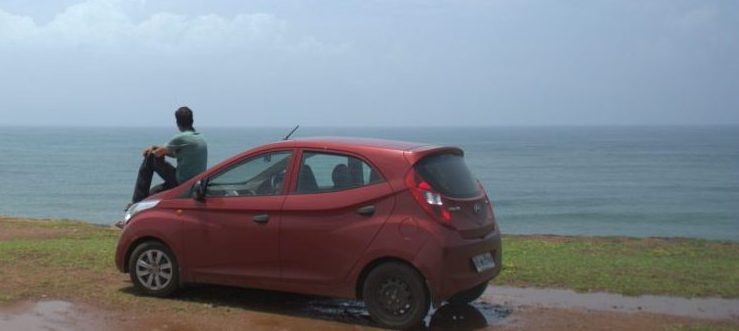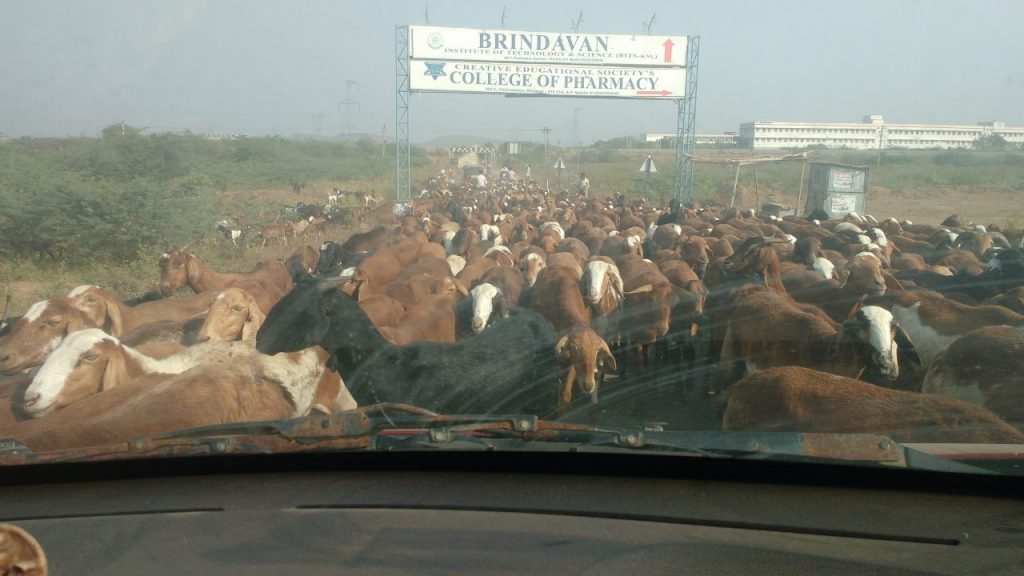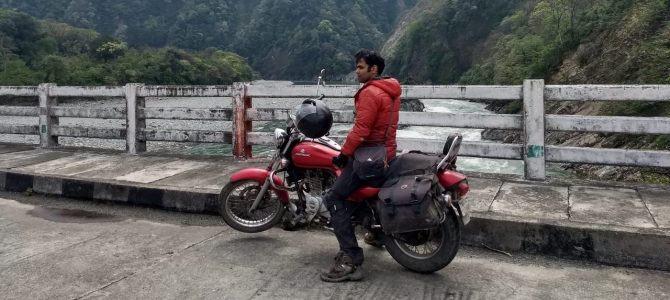India 360 was a unique trip in terms of modes of transport used. We had three phases in the trip based on the vehicle used. During the first part of the trip, i.e. north Indian Himalayas between April to July 2017, we used public transport. Phase 2 and 3, were covered by car and motorbike respectively. We used our Hyundai EON Magna while driving around peninsular India, i.e. the west coast from Gujarat to Kerala and the east coast from Tamil Nadu to Andhra Pradesh and the Deccan plateau in between. For the phase of our trip that covered eastern and north eastern India, we used our newly purchased second-hand Bajaj Avenger motorcyle. We drove or rode over more than 30,000 km of the country’s roads. So, in this post, we wish to share some things you may already know about driving in India, and some things we learnt by good fortune and from mistakes. We are covering the post in the form of Q&A.
Is it safe to drive / ride around India?
It is never fully safe to ride or drive anywhere in the world. Even Sweden or Denmark aren’t free of road accidents. If you start living your life by avoiding risks, you will end up limiting your options and having less fun. It is reasonably safe to drive around India if you follow safe driving rules, even if the others around you are driving like they have left their brains at home. The fact that we are back from the trip and writing this blog is testimony for our statement. The thousands of motorbike tours and car convoys that have driven around the country will vouch for it and echo our statement too. There are few who haven’t lived to tell the tale, but that is true for road-trippers in every country in the world. We will cover some safe driving tips and tricks in a question in this post.
Which vehicle is the best to drive around the country?
Hari: My favourite is a sturdy motorbike (minimum 150cc). The mileage should be good too. At least 40 kilometres per litre, so that the fear of running out of fuel will not worry you. The wider the tyres, the better. Carrying a two-man tent and a 60 – 70 litre rucksack should suffice for two persons. Royal Enfield purists swear that theirs is the only motorbike capable of travelling comfortably over long distances. But I have made no such observation. Any 150cc+ motorbike does the job pretty well as I have observed for ourselves and for many motorbike travellers we saw along the way. Travelling by motorbike makes you prone to backaches and hence limits how much you can ride per day.
For a more comfortable journey, my favourite would be a compact car of 800 – 1000 cc. Would a car like that tackle the Himalayan roads? Even a 600 cc Tata Nano can ascend the steep slopes with ease on the better roads of Himayalas. That said, any hatchback or sedan with low ground clearance is unsuitable for those HImalayan roads which have atrocious conditions. While, SUV advertisements pitch themselves to be the best for the Himalayas, I have often seen that with their bigger size they keep ducking to the side of the narrow roads while allowing trucks and army vehicles to pass. For Himayalan roads, I feel that motorbikes are a better fit.

Our hatchback, Hyundai EON Magna, is comfortable for long drives, but cannot handle the part of Himalayas with bad roads.
What documents do I need to carry?
The following documents are mandatory and must be available immediately if any traffic cop asks you.
1. Your driving license. Make sure that only a person with a valid driving license is driving the vehicle. A driving license expires every 20 years and must be renewed on expiry. India accepts foreign driving licenses, as long as they are printed in English. If a license is printed in a language other than English, you need to procure an International Driving Permit, which translates the contents of your license into 18 languages, from the transport office that issued your license.
2. Registration book: is a smart card / booklet that assigns an all-India unique number to your vehicle. The number is matched to your vehicle chassis number on an all-India database. The registration number must also be visible on your vehicle on a white-coloured board with black lettering if you are driving your own vehicle. If your vehicle is rented, then it must display yellow letters on a black coloured board. Registration expires every 15 years.
3. Insurance: An insurance policy that covers damage to people and property other than your vehicle and yourself is compulsory and must be renewed every year. This is referred to as a third-party damage insurance. In addition, you can get a comprehensive insurance that also covers damages to your vehicle and medical treatments for you.
4. Pollution Under Control certificate: is a small paper certificate issued by a pollution testing centre to validate that your vehicle’s emissions are within the norms mandated by the transport department. A certificate is valid for only six months and must be renewed twice every year.
How much should one ride everyday?
The first point we lead with is NEVER to ride after 5 pm. By 5 pm, you should be inside a hotel room or at your destination, such as a friend’s or relative’s home. We made exceptions to that rule in familiar cities, but never in places we had no idea about. Driving after dusk throws up a completely new set of probabilities for accidents. Vehicles from the opposite direction drive with beams fully powered, blinding your eyes. People get drunk and return home from bars. Roads are poorly lit and you cannot see much to your front. Rain at night wreaks havoc with visibility and balance. And so on.
On a motorbike, the practical distance to cover each day was between 150 – 200 km for us. Your fitness may give you a different experience. With a car, we even drove 500 km on a single day. Most often, you will not need to cover such distances because you will already be in next town with sight-seeing features and hence, worthy of looking for a lodge. Our average distance driven per day didn’t exceed 100 km. It dropped to a mere 30 km in Goa. Andhra Pradesh and Arunachal Pradesh needed us to drive 200 km every day for multiple days in a row.
How should we schedule fuel stops?
The answer to this question varies by region. In the Indian plains, you are practically assured of a fuel (petrol and diesel ONLY) pump every 25 km. 50 km is the farthest you will travel without finding a pump. It is not a valid assumption if you are driving in the mountainous regions of India, such as the Himayalas, Sahyadris, Niligiris or Araku valley. In those cases, fill up your tank in the most major town in the area before you leave for the mountains. If you are driving a low mileage vehicle such as an Enfield, you may even need to carry a couple of cans of petrol with you.
Fuel types other than petrol and diesel are NOT ready for an all India driving trip yet. There aren’t enough natural gas pumps in India to cover you for a country-wide trip. Taking an electric vehicle for an all India tour is still a dream an some automobile engineer’s drawing board.
How often should we service the vehicle?
Make it a point to service your vehicle as soon as you reach a tier 1 or tier 2 city, e.g. Mumbai, New Delhi, Bengaluru, Chennai, etc. The good points about these cities is that even if you vehicle needs to stay at the service station for a day, the cities have enough alternative transport to let you explore the sight-seeing places. If you have taken your vehicle for a bumpy road over the Himalayas, then take your vehicle in for a service as soon as you reach the nearest town with a service station. If you hear strange sounds in your vehicle, then stop over at the first habitation where you find a mechanic, hoping that they know what they are doing.
What are some safe driving tips throughout India?
1. Only persons with valid driving licenses and sufficient driving experience must drive during the entire trip. An all-India road trip is not the best stage for driving lessons or practice. That should be restricted to the area around your home or in a driving school.
2. Do not ride after dusk. Under no situation.
3. Always slow down at a junction, even if the traffic light shows green for your side. You never know when a ‘smart person’ suddenly decides that he can successfully jump the signal and get away before you have the time to react.
4. Never exceed 80 kmph even on national highways. The thrill isn’t worth the risk.
5. Never exceed 40 kmph on a mountain road.
6. Always switch your headlights on as soon as dusk sets in. Try not to use your headlights on high beam since that hurts others’s eyes. But if the road is poorly lit, then you have no choice.
7. Always make sure that your tyres are at the right pressure. Lower pressure leads to punctures and higher may lead to a burst.
8. Do not drive when your tyre treads are worn out. Get a new tyre or at least a second-hand tyre with treads intact.
9. Do not continue riding your motorbike in heavy rain or snow. You may have to stop for the day at the next habitation if the rain is really heavy and showing no signs of stopping.
10. On a snowed out day, wait for the army to clear the snow and give the go-ahead. In fact, allow a few more experienced motorists to drive ahead of you and follow them. You may need to return and stay put at your hotel while the army clears the snow. There is no point waiting right where the army is clearing the road. It may impede their progress.
11. During heavy rain, close the windows of your car and switch the air conditioner on even if at a low cooling setting. This will prevent your front windshield from fogging your breath and forming patches through which you can’t see. Do not drive your car in snow.
12. Always assume that the person driving in front of you can take a turn across your path without signalling to you. Anticipate it, slow down and keep your distance.
13. Due to point 12, before you attempt to overtake a vehicle, pause for at least three seconds and drive at the same speed as the vehicle at least 10 metres behind it to check if that vehicle won’t do something you don’t expect it to, e.g. a sudden stop, a sudden turn across your path, a sudden change of lane, etc. If something were to happen even if technically it’s their fault, your vehicle and you will also suffer damage and injury.
14. Always be wary of rickshaw drivers, poorly driving two wheelers and poorly riding bicyclists. If your instinct tells you that one of them is about to do something unexpected, then your instinct is usually spot on.
15. Crossing cattle is a nightmare in India. It deserves it own question.
How do I deal with cattle crossing the road?

A huge herd of goats blocked us on the way to Kurnool, Andhra Pradesh. We had to switch our car off and wait for 10 minutes to let them clear.
Here’s how different types of cattle behave. These are our observations throughout India and not empirically proven facts. I hope to give you a heads up based on our experience.
#1. Bovines (Cows & buffaloes): Never attempt to cross a bovine in front of it. Bovines stop and start moving several times while crossing. You cannot predict their speed or forward movement reliably. A good thing about bovines is that they never walk backwards or retrace their paths. If a bovine is in the middle of the road with enough space for you to drive around it, that’s what you should do. But behind the animal, not in front of it. A sitting bovine ignores all the vehicles without a care in the world. A reasonable assumption is that it won’t get up for your vehicle and will continue to hog the road. You can safely drive around it in any direction.
#2. Dogs, cats, roosters: The problem with these three creatures is that they appear to cross the road confidently, but panic on seeing your vehicle and retrace their path. You will be thoroughly confused about which way to swerve to avoid hitting them. It’s best to slow down a few metres in front of their path, even come to a stop, so that they cross without panic.
#3. Goat and sheep: Goat and sheep have a strange panic habit. On seeing you, they run in the same direction as your vehicle, trying to outrun your horsepower to get away from you. Like category #2, it is best to slow down or stop to let them ease off the road.
#4. Wild life! I am talking about big cats and even elephants. Yes, it does happen in India. Wild felines and elephants routinely cross national highways and surprise motorists. Call us lucky not to have encountered such a thing. Or perhaps unlucky not to enjoy such a sighting. This tip comes from forest rangers and trackers. On a four-wheeler you should roll up all your windows and start reversing slowly, carefully not to rev your engine so hard that it sounds like a growling threat to the animal. On a motorbike, kill the engine and don’t move if the animal hasn’t spotted you or doesn’t care about your existence. A revving engine might imitate growling, so better not to engage the animal. I have no tips to offer you if the animal spots you and doesn’t seem pleased. Just pray!
What if my vehicle breaks down?
On many national highways in India, the various numbers for road assistance are printed on highway signs. Your vehicle manufacturer’s manual mentions their highway assistance number too. In remote places like the north-east, the local truck drivers are nice enough to give your motorbike and you a ride to the nearest garage. In remote places like mountains, you many need to wait endlessly and patiently for help to arrive. Your best bet is to prevent a breakdown by servicing your vehicle regularly.
Would you recommend travelling in groups of vehicles?
It depends on your preference. Riding with groups is safer and problems can be handled together. But the slowest member of the group dictates the speed of the trip. This is something you will have to get used to. Also, it is easier to assemble groups for dedicated routes like Manali – Leh over a short duration such as a week to three weeks. It’s unlikely that anyone would take kindly to a year-long plan for driving all around India, since that requires a lot of decision making over career, finance and time spent.
Conclusion
Driving around India sounds thrilling and intimidating at the same time. Some doubts are common and hopefully we have addressed them in today’s post. Whatever your inhibitions, do not back out of a road trip around India due to doubt and uncertainty, since that decision may come back to haunt you on an opportunity missed.

